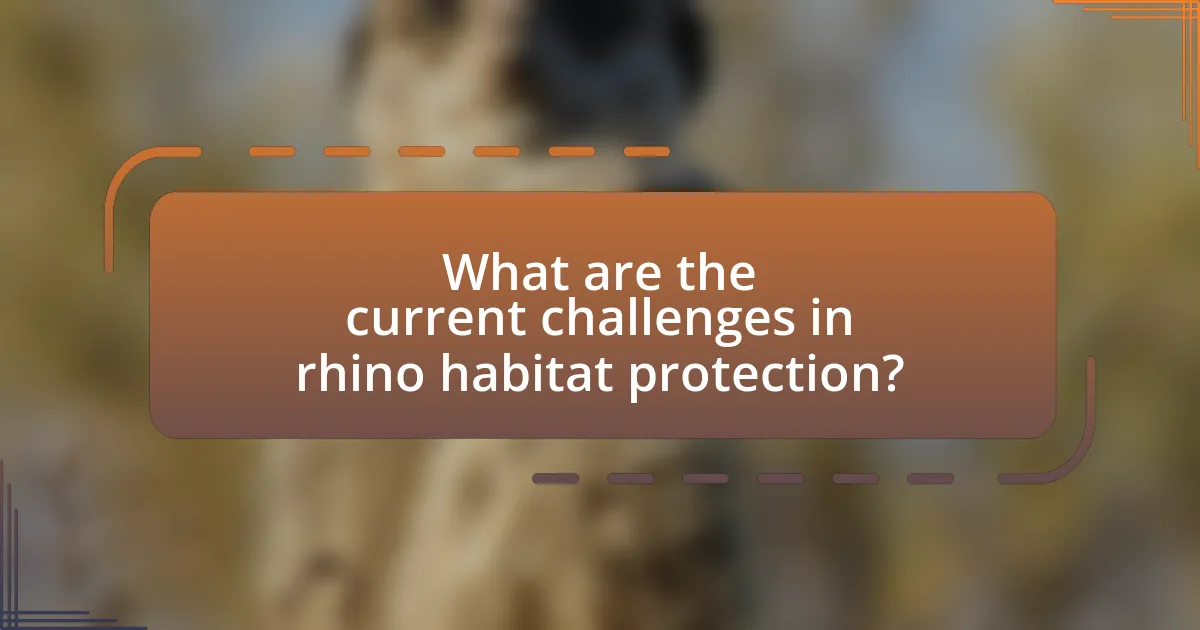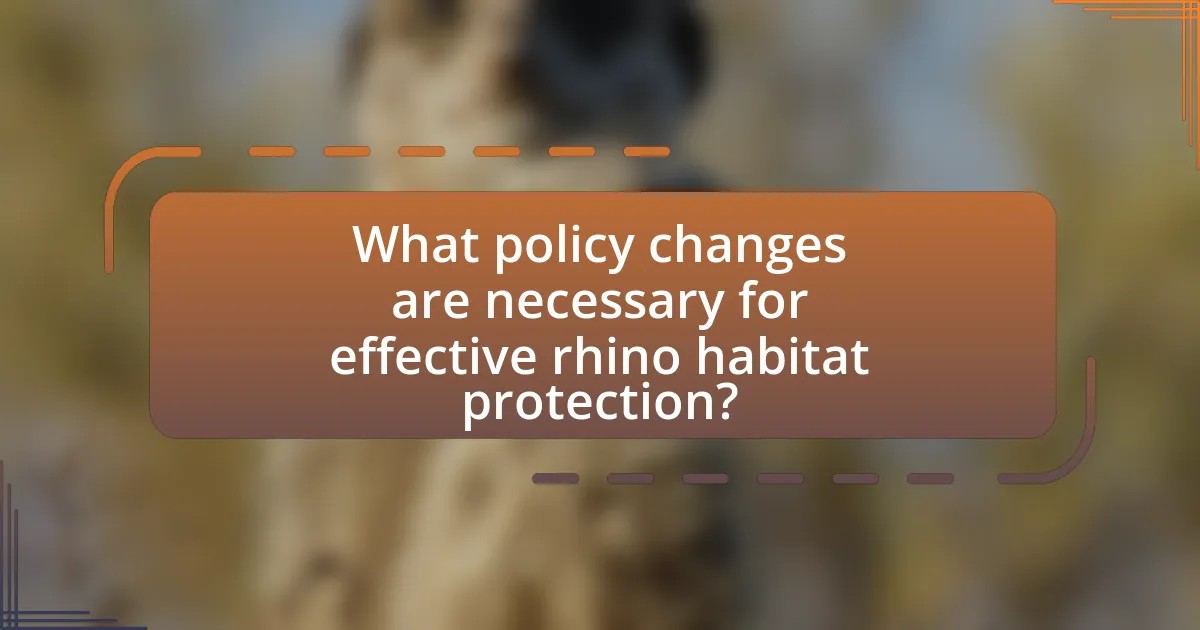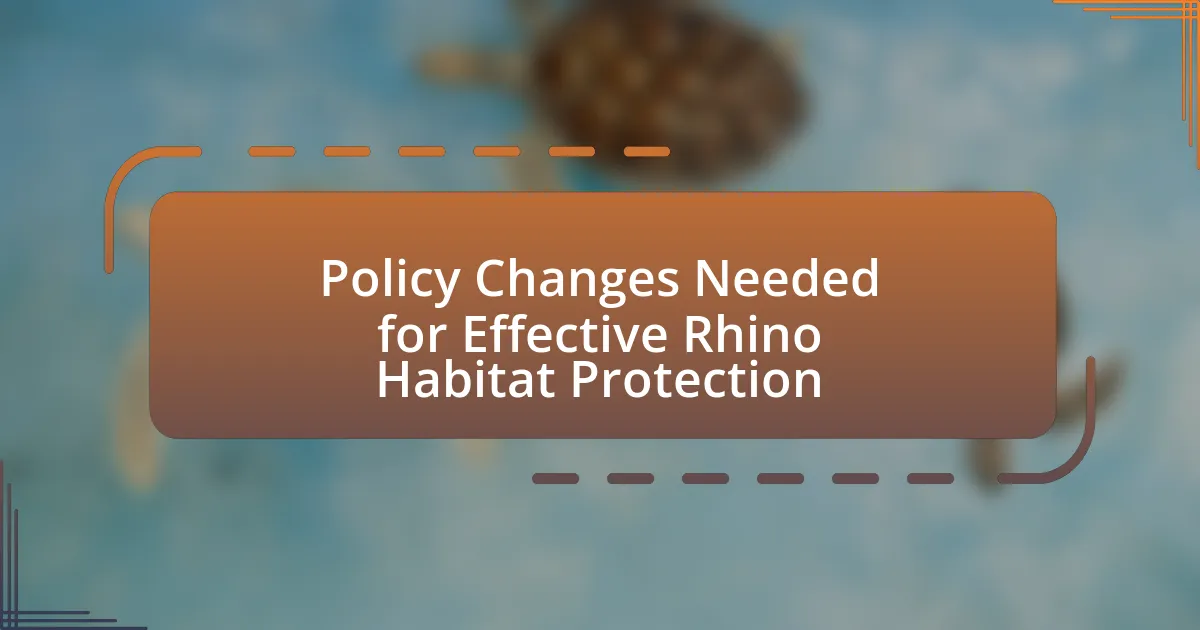The article focuses on the critical need for policy changes to enhance rhino habitat protection. It outlines the current challenges faced in conservation efforts, including habitat loss due to agricultural expansion, poaching driven by illegal wildlife trade, and the impacts of climate change. The importance of effective habitat protection for rhinos is emphasized, highlighting their ecological roles and the consequences of habitat degradation on their populations. Additionally, the article discusses existing policies, their effectiveness, gaps in current frameworks, and necessary legislative measures to strengthen conservation efforts. It concludes with recommendations for improving stakeholder engagement and monitoring strategies to ensure the successful implementation of habitat protection policies.

What are the current challenges in rhino habitat protection?
Current challenges in rhino habitat protection include habitat loss due to agricultural expansion, poaching driven by illegal wildlife trade, and climate change affecting ecosystem stability. Habitat loss is significant, with over 90% of rhino populations historically impacted by land conversion for farming and urban development. Poaching remains a critical threat, as rhino horns are highly valued in black markets, leading to increased illegal hunting. Additionally, climate change poses risks by altering habitats and food availability, further stressing rhino populations. These factors collectively hinder effective conservation efforts and necessitate urgent policy changes to address these challenges.
Why is effective habitat protection crucial for rhinos?
Effective habitat protection is crucial for rhinos because it directly impacts their survival and reproductive success. Rhinos require large, undisturbed areas to thrive, as their habitats provide essential resources such as food, water, and shelter. According to the International Rhino Foundation, habitat loss due to agriculture, urban development, and poaching has significantly reduced rhino populations, with some species facing extinction. Protecting their habitats not only preserves biodiversity but also ensures that rhinos can maintain stable populations, which is vital for the ecological balance of their environments.
What are the ecological roles of rhinos in their habitats?
Rhinos play crucial ecological roles in their habitats primarily as megaherbivores that shape vegetation dynamics. By grazing on grasses and browsing on shrubs, rhinos help maintain the balance of plant communities, preventing overgrowth and promoting biodiversity. Their feeding habits create open spaces that benefit other species, allowing for a diverse range of flora and fauna to thrive. Additionally, rhinos contribute to nutrient cycling through their dung, which enriches the soil and supports plant growth. Studies have shown that areas with healthy rhino populations exhibit greater plant diversity and abundance, highlighting their importance in ecosystem health and resilience.
How does habitat loss impact rhino populations?
Habitat loss significantly reduces rhino populations by diminishing their living space and food sources. As natural habitats are converted for agriculture, urban development, or other human activities, rhinos face increased competition for resources, leading to malnutrition and decreased reproductive success. According to the International Union for Conservation of Nature, habitat loss is one of the primary threats to rhinos, contributing to a decline in their numbers by over 90% in some regions over the past century. This loss not only affects individual rhinos but also disrupts their social structures and breeding patterns, further endangering their survival.
What policies currently exist for rhino habitat protection?
Current policies for rhino habitat protection include the establishment of protected areas, anti-poaching laws, and international trade regulations. Protected areas, such as national parks and wildlife reserves, are designated to conserve rhino habitats and their ecosystems. Anti-poaching laws, enforced in countries like South Africa and Namibia, impose strict penalties for illegal hunting and trafficking of rhinos. Additionally, the Convention on International Trade in Endangered Species (CITES) regulates international trade of rhino products, aiming to prevent exploitation. These policies are supported by various conservation organizations and government initiatives, which have shown effectiveness in stabilizing some rhino populations in specific regions.
How effective are existing policies in conserving rhino habitats?
Existing policies in conserving rhino habitats are moderately effective but often lack comprehensive enforcement and adequate funding. For instance, the Convention on International Trade in Endangered Species (CITES) regulates international trade of rhino horns, yet poaching rates remain high due to insufficient local law enforcement and corruption. Additionally, national policies in countries like South Africa and India have made strides in habitat protection, but habitat loss continues due to agricultural expansion and human encroachment. According to the World Wildlife Fund, habitat loss is a primary threat to rhinos, indicating that while policies exist, their implementation and effectiveness are hindered by various socio-economic factors.
What gaps exist in current policy frameworks?
Current policy frameworks for rhino habitat protection exhibit significant gaps, particularly in enforcement, funding, and stakeholder engagement. Enforcement mechanisms often lack the necessary resources and personnel to effectively combat poaching and habitat destruction, leading to insufficient protection for rhinos. Additionally, funding for conservation initiatives is frequently inadequate, with many programs relying on inconsistent donor support rather than stable government investment. Stakeholder engagement is also limited, as local communities are often excluded from decision-making processes, which undermines the effectiveness of conservation strategies. These gaps hinder the overall success of policies aimed at protecting rhino habitats and ensuring the survival of the species.

What policy changes are necessary for effective rhino habitat protection?
Effective rhino habitat protection requires the implementation of stricter anti-poaching laws and enhanced land-use policies. Stricter anti-poaching laws would deter illegal hunting, which has significantly reduced rhino populations; for instance, in South Africa, rhino poaching increased from 13 in 2007 to over 1,000 in 2014. Enhanced land-use policies would ensure that habitats are preserved and not converted for agriculture or urban development, as habitat loss is a critical threat to rhinos. These policy changes are essential to create a sustainable environment for rhinos, ensuring their survival and the integrity of their ecosystems.
How can land use policies be improved to benefit rhinos?
Land use policies can be improved to benefit rhinos by integrating wildlife conservation into land management frameworks. This can be achieved by designating protected areas specifically for rhino habitats, ensuring these zones are free from agricultural expansion and urban development. For instance, the establishment of wildlife corridors allows rhinos to migrate safely between habitats, reducing human-wildlife conflict and promoting genetic diversity. Evidence from the International Union for Conservation of Nature indicates that protected areas can significantly enhance rhino populations, as seen in regions like South Africa, where dedicated conservation efforts have led to population increases. Additionally, involving local communities in conservation efforts through incentives can foster coexistence and reduce poaching, further supporting rhino populations.
What role do protected areas play in rhino conservation?
Protected areas are crucial for rhino conservation as they provide safe habitats that protect rhinos from poaching and habitat loss. These designated regions help maintain stable populations by offering secure environments where rhinos can thrive without the threat of human encroachment. For instance, in South Africa, the establishment of Kruger National Park has been instrumental in increasing the white rhino population from fewer than 100 individuals in the 1900s to over 18,000 today, demonstrating the effectiveness of protected areas in conservation efforts.
How can community involvement enhance habitat protection efforts?
Community involvement enhances habitat protection efforts by fostering local stewardship and increasing awareness of conservation issues. Engaging communities in habitat protection initiatives leads to greater investment in local ecosystems, as residents often have a personal connection to their environment. Studies show that when communities participate in conservation activities, such as monitoring wildlife or restoring habitats, they are more likely to support and sustain these efforts over time. For instance, a report by the World Wildlife Fund highlights that community-led conservation projects in Africa have resulted in a 50% increase in wildlife populations in some areas, demonstrating the effectiveness of local engagement in habitat protection.
What legislative measures can support rhino habitat protection?
Legislative measures that can support rhino habitat protection include the establishment of protected areas, stricter anti-poaching laws, and incentives for sustainable land use. Protected areas, such as national parks and wildlife reserves, provide safe habitats for rhinos, reducing human-wildlife conflict and habitat destruction. Stricter anti-poaching laws, including harsher penalties for poachers and traffickers, deter illegal activities that threaten rhinos. Additionally, incentives for sustainable land use encourage local communities to engage in conservation efforts, promoting coexistence between human activities and wildlife. For instance, the establishment of the African Elephant Conservation Act has shown that targeted legislation can effectively protect endangered species and their habitats.
How can anti-poaching laws be strengthened?
Anti-poaching laws can be strengthened by increasing penalties for poaching and trafficking, enhancing enforcement capabilities, and improving community engagement. Stricter penalties, such as longer prison sentences and higher fines, serve as a deterrent against poaching activities. For instance, countries like Kenya have implemented harsher penalties, resulting in a decrease in poaching incidents. Enhancing enforcement capabilities involves providing better training and resources to wildlife rangers, which has been shown to improve on-the-ground effectiveness in countries like South Africa. Furthermore, engaging local communities in conservation efforts fosters a sense of ownership and responsibility, leading to increased reporting of poaching activities. Studies indicate that community-based conservation programs can reduce poaching rates by up to 50%.
What incentives can be provided to landowners for habitat conservation?
Financial incentives such as tax breaks, grants, and cost-sharing programs can be provided to landowners for habitat conservation. These incentives encourage landowners to engage in practices that protect and restore habitats, which is crucial for species like rhinos. For instance, the Conservation Reserve Program in the United States offers annual rental payments and cost-share assistance to landowners who convert environmentally sensitive land into conservation practices. Additionally, payments for ecosystem services can be implemented, where landowners receive compensation for maintaining ecosystem functions that benefit society, such as carbon sequestration and biodiversity preservation. These approaches have been shown to effectively motivate landowners to prioritize habitat conservation, thereby contributing to the overall protection of endangered species.

What are the best practices for implementing policy changes?
The best practices for implementing policy changes include engaging stakeholders, conducting thorough research, and ensuring clear communication. Engaging stakeholders, such as local communities and conservation organizations, fosters collaboration and support, which is crucial for successful policy adoption. Research provides evidence-based insights that inform policy decisions, ensuring they address the specific needs of rhino habitat protection effectively. Clear communication of the policy’s goals and benefits helps to align all parties involved and facilitates smoother implementation. These practices are supported by case studies in conservation efforts, demonstrating that inclusive and informed approaches lead to more effective policy outcomes.
How can stakeholders collaborate for effective policy implementation?
Stakeholders can collaborate for effective policy implementation by establishing clear communication channels and shared objectives. This collaboration involves regular meetings, joint workshops, and the creation of task forces that include representatives from government, NGOs, local communities, and the private sector. For instance, the International Union for Conservation of Nature (IUCN) emphasizes the importance of multi-stakeholder partnerships in conservation efforts, which have been shown to enhance policy outcomes by integrating diverse perspectives and resources. Such collaborative frameworks enable stakeholders to align their goals, share best practices, and mobilize funding more effectively, ultimately leading to more successful policy implementation in rhino habitat protection.
What role do NGOs play in advocating for policy changes?
NGOs play a crucial role in advocating for policy changes by mobilizing public support, conducting research, and influencing decision-makers. They raise awareness about issues affecting rhino habitats, such as poaching and habitat loss, and provide evidence-based recommendations to policymakers. For instance, organizations like the World Wildlife Fund have successfully lobbied for stronger anti-poaching laws and habitat conservation measures, demonstrating their impact on legislative processes. Through campaigns, partnerships, and grassroots efforts, NGOs effectively shape environmental policies that protect rhinos and their ecosystems.
How can local communities be engaged in policy development?
Local communities can be engaged in policy development through participatory approaches that include consultations, workshops, and collaborative decision-making processes. These methods allow community members to voice their concerns, share local knowledge, and contribute to the formulation of policies that directly affect their environment and livelihoods. For instance, the International Union for Conservation of Nature (IUCN) emphasizes the importance of involving local stakeholders in conservation efforts, as their insights can lead to more effective and sustainable policies. Engaging communities not only fosters ownership of the policies but also enhances compliance and support for conservation initiatives, which is crucial for effective rhino habitat protection.
What monitoring and evaluation strategies are needed?
Effective monitoring and evaluation strategies for rhino habitat protection include systematic data collection, biodiversity assessments, and stakeholder engagement. Systematic data collection involves using technology such as GPS tracking and remote sensing to monitor rhino populations and habitat conditions. Biodiversity assessments provide insights into ecosystem health and the presence of other species, which can indicate the effectiveness of habitat protection efforts. Stakeholder engagement ensures that local communities are involved in conservation efforts, fostering collaboration and compliance with protection policies. These strategies are supported by studies showing that integrated monitoring frameworks improve conservation outcomes, as evidenced by successful rhino population recoveries in protected areas.
How can the effectiveness of new policies be assessed?
The effectiveness of new policies can be assessed through measurable outcomes and specific indicators related to the policy’s objectives. For instance, in the context of rhino habitat protection, metrics such as population growth rates of rhinos, habitat area preserved, and reduction in poaching incidents can serve as indicators of policy success. Studies have shown that policies leading to increased protected areas correlate with higher rhino populations, as evidenced by the success of the African Rhino Conservation Strategy, which reported a 20% increase in rhino populations in protected regions over five years. Thus, systematic data collection and analysis of these indicators provide a concrete basis for evaluating policy effectiveness.
What indicators should be used to measure habitat health?
Indicators used to measure habitat health include biodiversity levels, soil quality, water quality, and vegetation cover. Biodiversity levels indicate the variety of species present, which is crucial for ecosystem resilience; for instance, a diverse range of flora and fauna can enhance habitat stability. Soil quality, assessed through parameters like nutrient content and pH, affects plant growth and overall ecosystem productivity. Water quality, measured by factors such as pH, turbidity, and pollutant levels, is essential for sustaining aquatic life and maintaining ecosystem balance. Vegetation cover, which can be quantified through remote sensing techniques, reflects habitat structure and availability of resources for wildlife. These indicators collectively provide a comprehensive assessment of habitat health, essential for effective conservation policies, particularly in the context of protecting rhino habitats.
What practical steps can be taken to advocate for policy changes?
To advocate for policy changes regarding effective rhino habitat protection, stakeholders should engage in targeted lobbying efforts, build coalitions, and utilize data-driven campaigns. Engaging in lobbying involves meeting with policymakers to present evidence on the importance of rhino conservation, which can be supported by statistics showing that rhinos contribute significantly to biodiversity and ecosystem health. Building coalitions with environmental organizations and local communities can amplify voices and create a unified front, enhancing the credibility of the advocacy efforts. Utilizing data-driven campaigns, such as presenting research from credible sources like the World Wildlife Fund, which highlights the economic benefits of preserving rhino habitats, can effectively persuade policymakers to enact necessary changes.
